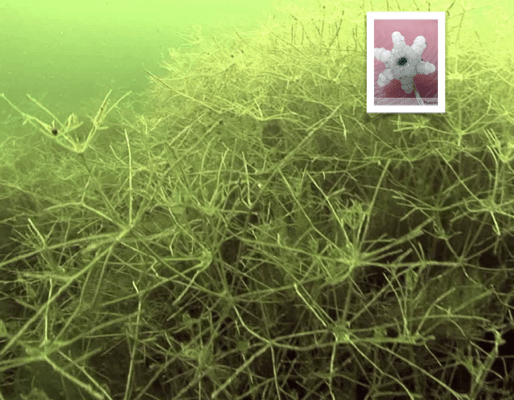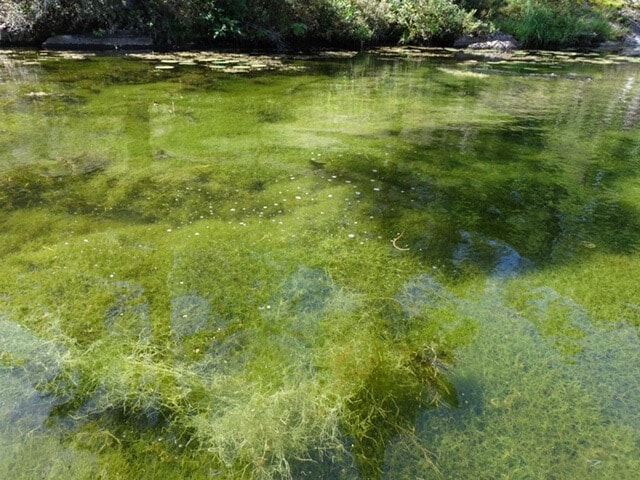A new invasive plant is rapidly spreading through the Kawartha Lakes
In 2018, a water plant by the charming name of starry stonewort (SSW) was identified in Stony Lake. Fast forward two years and this highly-aggressive, invasive aquatic species is now turning up all over the Kawarthas. For many cottagers and lakeside residents, the impacts have been hard to watch. They have seen firsthand how quickly the species spreads and the huge impact it has on the biodiversity and recreational use of infested areas.

SSW (Nitellopsis obtusa) has been present in North America for at least four decades. A macro-alga native to Europe and western Asia, it was introduced to the Great Lakes-St. Lawrence region in 1978 via the ballast water in ships and has spread into Lake Simcoe and other inland lakes over the last decade. In 2015, it was found in Lake Scugog where it now represents a dominant component of the aquatic plant community. SSW is typically associated with fairly shallow, low-flow water bodies, which makes many lakes in the Kawarthas prime habitat. In addition to Lakes Simcoe and Scugog, it can now be found in Sturgeon, Pigeon, Upper and Lower Buckhorn, Rice, Big Cedar, and Lower Stony Lake where it has proliferated over the last few years. SSW is present throughout Gilchrist Bay and the Lost Channel and was most recently identified in nearby Mackenzie Bay.
Jennifer Wortzman, a long-time Stony Lake cottager, says that seeing SSW in the Lost Channel is heart breaking. “That’s such a beautiful part of the lake. It’s an annual event for so many community members to paddle through the channel. It’s also disheartening to see people ignoring all the warnings about driving their boats through areas like these. They’re spreading stonewort all over the lake.”
According to a risk assessment submitted to the Ministry of Natural Resources and Forests in 2017, SSW has “a probability of invasion rating of Very High and an impact rating of High Negative.” In other words, it could eventually become a huge problem in Ontario, especially with the increase in water temperatures and longer growing seasons associated with climate change.
Identification and dispersal
Although its name might suggest something related to astronomy or even geology, SSW is actually a green macro alga – in other words, an alga with the size and shape of a real plant. It forms large, dense mats in water anywhere from one-half to 10 metres in depth. The mats can be up to three metres deep and dense enough to impede boating or paddling. At the peak of the growing season from late July to late September, the mats appear as hill-like mounds under the surface of the water. The alga’s branchlets and stems are very thin (like heavy fishing line), light green in colour, and have a hard, “crunchy” feel. In fact, they make a popping noise when squeezed.
Although it lacks a true root system, SSW is anchored by clear filaments. It simply hangs above the lake bottom where it creates an anoxic or oxygen-deprived layer. The filaments produce white, star-shaped bulbils, which are the reproductive structures that give SSW its name and make it so difficult to eradicate. Because SSW is often intermingled with other aquatic species, finding it can sometimes be difficult.
SSW spreads easily and rapidly by the dispersal of plant fragments and the bulbils described above. The process is accelerated when boats travel through infested areas. Their propellers tear off strands of the plant and redistribute them into new areas.
Environment Council Action
The Environment Council for Clear, Stony and White Lakes began taking action last summer. This included posting information on their website and putting up signs in infested areas and at public access points warning visiting boaters that SSW is present in the lake. Information sheets were created and distributed to resident cottagers, and presentations were made to all four township councils with jurisdiction around the lakes. The Environment Council’s message was that there needs to be joint action by the province, the surrounding townships, the Trent-Severn Waterway, and Parks Canada to deal with this problem.
“The Environment Council is doing its best to keep everyone informed. However, we all have a responsibility to be informed and to use common sense to help prevent the spread of this highly aggressive invasive alga” said Ed Paleczny, the Environment Council chair. The Council is posting a “Best Management Practices” document on their website (see below) to provide practical advice for cottagers, businesses, and commercial weed harvesters on how to prevent the spread of SSW.
The Environment Council now has a team that will investigate any sightings of SSW in Clear, Stony and White Lakes. If you think you’ve spotted the species, please go their website at http://www.environmentcouncil.ca/starry-stonewort and click on the REPORT SSWbutton. If possible, also send a photo of the area and the alga for verification. The website has maps showing confirmed areas of infestation.
Preventing the spread
Right now, there is no way to eradicate SSW. However, the plant is sometimes harvested to facilitate boat travel and to improve recreational use of the lake. Unfortunately, harvesting does not eradicate the species but actually increases the risk of spread by fragments. Plant removal is regulated by the Ministry of Natural Resources and Forests in all inland waters except the Trent Severn Waterway and Rideau Canal. In the latter two areas, a Parks Canada permit is required to harvest and remove any aquatic vegetation. The Department of Fisheries and Oceans also has jurisdiction, since it is responsible for protecting critical habitat for warm water fish like perch, bass, and muskellunge.
If the spread of SSW is to be slowed, it is important to avoid boat travel from infested areas into non-infested waters. If you absolutely need to travel in or through an infested area, stop and lift your boat motor and remove all weeds. The weeds must then be placed in a bucket and taken to dry land and disposed of away from any water. You should also clean and dry your watercraft before leaving an infected lake. Check your boat exterior and trailer for any vegetation, and drain live wells, bait buckets, and bilges. You should also ensure that any commercial harvester that you hire to remove weeds on your waterfront has a permit from the Trent-Severn Waterway. It is critical that any commercial weed harvester is not moving in and out of infested areas. You must be sure that the weed harvester is clean, drained, and dry before working on your waterfront, otherwise you are at high risk of waking up to SSW right off your dock.

Impacts and Research
As SSW continues to expand, significant environmental and economic impacts on the Kawartha Lakes appear certain. The alga disrupts healthy functioning ecosystems as infested areas rapidly form a monoculture. It can even eliminate Eurasian watermilfoil, which is another infamous invasive species in the Kawarthas. Because of the loss of plant diversity, the habitat becomes less inviting for fish and other species. This, in turn, poses a serious threat to the future of sport fishing. The disruption of popular recreational activities such as swimming, boating, and fishing has a serious economic cost, too, especially when it comes to tourism.
On Lake Scugog, the Scugog Lake Stewards are partnering with the University of Ontario Institute of Technology to further study the prevalence and ecological impact of SSW on the biological community. In related research, doctoral student Tyler Harrow-Lyle is trying to determine the biogeographical drivers of the invasion as well as its impacts on ecosystem function. I recommend checking out a short YouTube video produced by the Scugog Lake Stewards, entitled “Macroscopic Algae: Starry Stonewort” It can be viewed at https://www.youtube.com/watch?v=J1clVTaX9fM
The final word goes to Terry Rees, president of the Federation of Ontario Cottagers Associations. “When it comes to aquatic invaders, the fact that SSW can outcompete and take over from a highly competitive invader like Eurasian watermilfoil is extremely troubling. People that love and use our lakes need to be ever vigilant about not spreading any of these species from place to place!”
CLIMATE CRISIS NEWS (please highlight in green)
ALARM: At the coldest point on Earth, temperatures are rising fast. Data from the South Pole shows that over the past 30 years, the region has warmed three times faster than the warming rate of the planet as a whole. The study was published Monday in the journal “Nature Climate Change”. “The South Pole seemed to be isolated from what was going on across the rest of the world,” said researcher Kyle Clem. “But all of a sudden, it ramps up with rapid warming, some of the strongest warming on the planet.” The researchers believe that part of the warming is part of a multi-decade natural process, but that the rest is due to human-induced climate change. So far, the temperature changes haven’t been significant enough to cause any massive ice loss at Antarctica’s interior. Still, the bottom line is that the Antarctic is “waking up” to climate change – and that is alarming.
ENCOURAGEMENT: Members of the local climate group, For Our Grandchildren, along with Malaika Collette of Peterborough Youth Empowerment, presented a motion to Peterborough County Council last week to declare a climate change emergency. The motion was passed with no changes after a long and largely positive discussion. The matter has now been referred to the Director, Corporate Projects & Services, for a report back to Council. Let’s hope the declaration is made!
For local climate news and ways to take action, visit https://forourgrandchildren.ca/ and subscribe to the newsletter